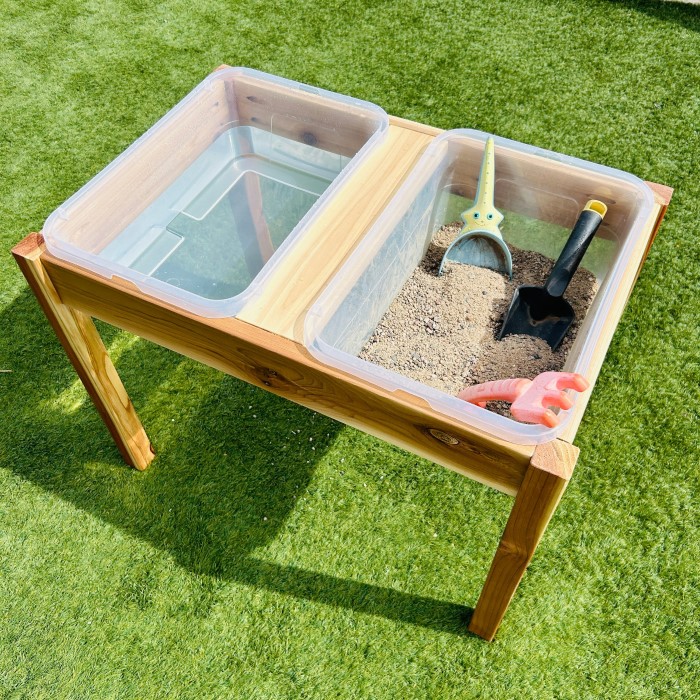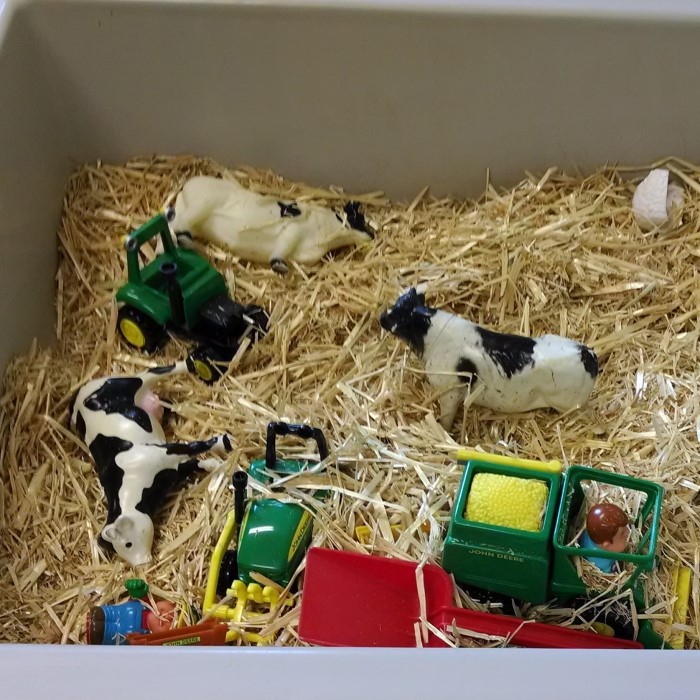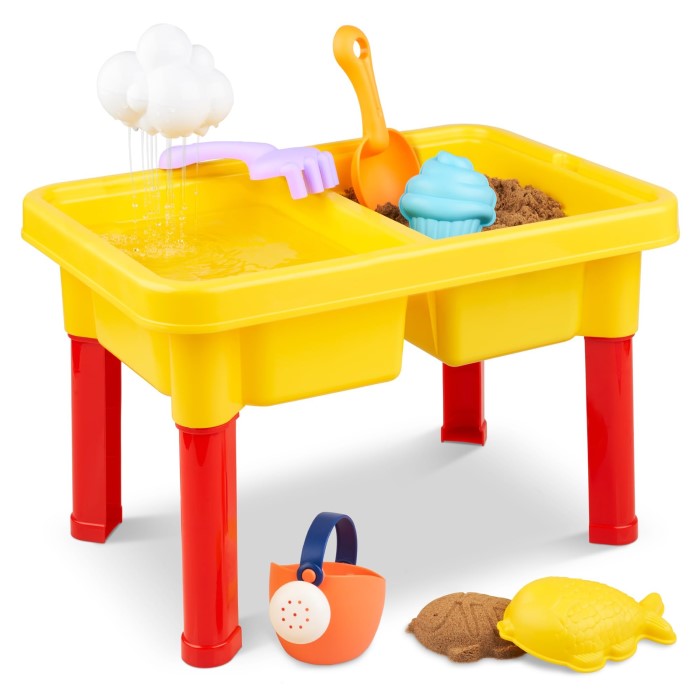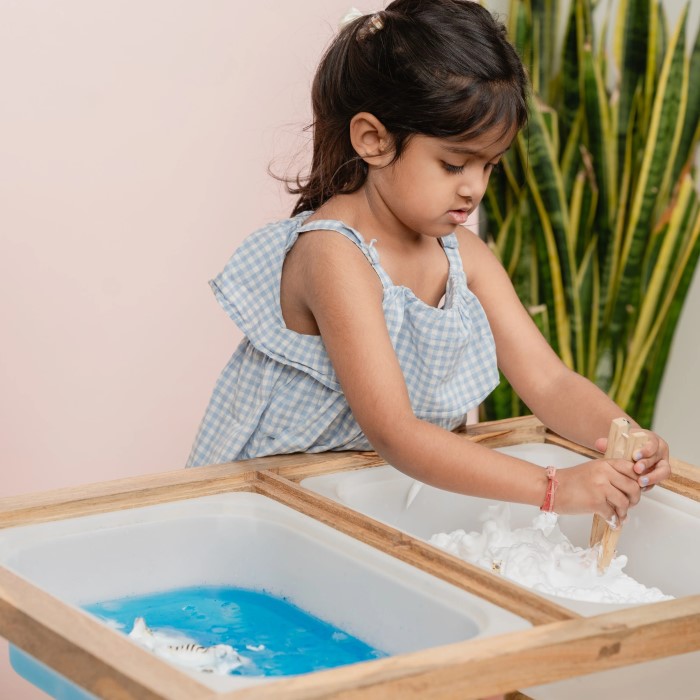What is a Sensory Bin Table?
Definition and Purpose
A sensory bin table is a tool for interactive, hands-on play. It typically features a container filled with various materials, designed to engage the senses. These materials may include items like sand, rice, water, or beads. Sensory bin tables encourage exploration through touch, sight, sound, and sometimes even smell. They are often used in homes, classrooms, or therapy settings to promote learning and creativity.
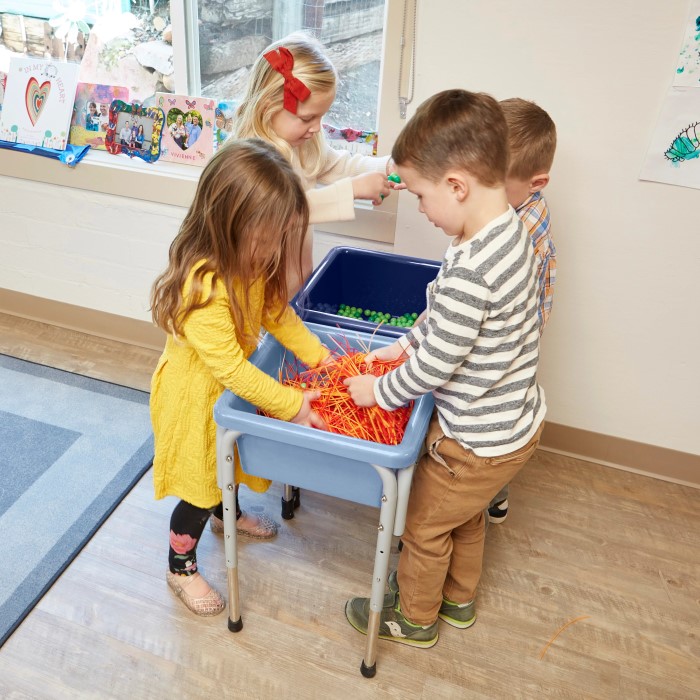
Benefits for Child Development
Sensory bin tables offer many developmental benefits for children. They help improve fine motor skills, such as scooping, pouring, and grasping objects. Children also develop problem-solving skills by interacting with diverse materials. Sensory play supports language development as kids describe textures and actions. It fosters focus and relaxation, making it great for stress relief. Additionally, sensory bin tables encourage imaginative play, helping children express creativity and build confidence.
Materials to Use
Sensory bin tables come alive with the right materials. The items you include determine the level of engagement and learning opportunities they provide. Choosing varied materials can help stimulate multiple senses simultaneously while making play time fun and educational.
Common Items to Include
Start with easy-to-find materials that many kids love. Here are some great options:
- Dry Goods: Sand, rice, beans, pasta, or oatmeal are popular choices.
- Water Play: Add plain water or mix it with soap bubbles or food coloring.
- Beads and Buttons: These enhance visual stimulation and promote fine motor skills.
- Nature Items: Leaves, pinecones, pebbles, shells, and sticks work well for outdoor themes.
- Art Supplies: Pom-poms, foam letters, or colored paper strips are versatile options.
- Toys and Figurines: Add small animals, cars, or action figures to create playful scenarios.
Ensure materials are safe and age-appropriate. Avoid small items for toddlers to prevent choking hazards.
Creative and Unusual Materials
Introduce unique items to spark curiosity and imagination. These can turn sensory bins into something extraordinary:
- Kinetic Sand: A moldable material that feels soft and fascinating to touch.
- Slime or Gels: Gooey textures add an exciting sensory experience.
- Glow-in-the-Dark Objects: Perfect for nighttime or space themes.
- Frozen Items: Ice cubes or frozen paint enhance temperature-based sensory exploration.
- Magnetic Materials: Use magnetic beads, fishing rods, or metal objects for science-based play.
- Edible Items: Incorporate candy or cereal for a safe-tasting experience.
- Eco-Friendly Alternatives: Use recycled materials like shredded paper or biodegradable packing peanuts.
Experimenting with unconventional materials not only piques interest but broadens creative horizons. Rotate materials often to keep sensory play fresh and engaging.
Themes and Ideas
Sensory bin tables can cater to various themes, keeping activities engaging and purpose-driven. Thoughtfully planned themes unlock opportunities for learning, creativity, and fun. Below are three popular categories to inspire your sensory bins.
Seasonal Inspirations
Celebrate the beauty of each season through themed sensory bin tables. These ideas help children explore nature and holidays:
- Spring: Fill the bin with artificial grass, plastic flowers, and toy insects. Add scoops for planting play.
- Summer: Use sand, seashells, and water as a beach theme. Include shovels and pails for digging.
- Autumn: Add dry leaves, small pumpkins, and pinecones for a fall-inspired theme. Use tweezers to pick items.
- Winter: Incorporate fake snow, cotton balls, and small penguins. Add mittens for sensory textures.
These seasonal bins encourage exploration while teaching children about changes in their environment.
Educational Concepts
Transform sensory bin tables into tools for targeted learning. These concepts boost understanding while keeping things playful:
- Numbers and Counting: Include numbered beads or foam numbers for math-themed activities. Use scoops for sorting numbers.
- Letters and Words: Add magnetic letters or wooden alphabets to promote language play. Combine match-and-find activities.
- Colors and Shapes: Use colorful buttons or shape-cut foam. Encourage sorting and matching tasks to build skills.
- Science Exploration: Incorporate magnetic objects, magnifying glasses, or small fossils for discovery-based learning.
Educational bins make learning enjoyable and interactive while engaging multiple senses.
Story-Based or Role Play Themes
Bring storytelling or imaginative play to sensory bin tables. Create scenes that encourage kids to act out roles:
- Pirate Adventure: Fill with sand, small treasures, and miniature pirate ships. Include a treasure map for drama.
- Dinosaur Dig: Use kinetic sand, mini dinosaur figurines, and toy fossils. Add brushes for excavation play.
- Fairy Tale Land: Add synthetic grass, small castles, and fairy figurines to create a magical kingdom.
- Space Exploration: Incorporate black beans, glow-in-the-dark stars, and toy rockets for an outer-space theme.
Story-based themes foster creativity and storytelling skills while making playtime extra captivating.
Different Age Groups
Sensory bin tables adapt well to suit different age groups. Using age-appropriate materials ensures safe and meaningful play. Let’s look at how sensory tables can benefit toddlers, preschoolers, and school-aged children.
Toddlers
Sensory bin tables for toddlers should prioritize safety and simplicity. Choosing larger, non-toxic materials helps prevent choking hazards. Examples include:
- Large pom-poms or fabric swatches for tactile exploration.
- Oatmeal, pasta, or rice for safe sensory play with scooping tools.
- Plush toys or colorful scarves to stimulate touch and sight.
Toddlers enjoy basic tasks like scooping or shaking objects. Keeping activities simple lets them focus on textures and motions. Sensory tables at this stage help develop gross motor skills and early curiosity.
Preschoolers
Preschoolers thrive with sensory tables that engage their imaginations and fine motor skills. Incorporate themed or educational elements to make play both fun and purposeful:
- Colored water beads or kinetic sand to encourage exploration and creativity.
- Alphabet magnets or numbers for language and math development.
- Toy animals, cars, or figurines for storytelling and role-playing activities.
By this age, children can begin sorting, matching, or creating scenes using sensory materials. These activities help build problem-solving skills while fostering self-expression and learning.
School-Aged Children
Older kids benefit from advanced sensory bin activities that cater to deeper interests and skills. Challenge their creativity and cognitive abilities with the following:
- Science kits with magnifying glasses for exploring fossils or magnetic objects.
- Space-themed bins with glow-in-the-dark stars and planets.
- Craft materials like beads, buttons, or foam shapes for hands-on projects.
School-aged kids can handle multi-step tasks, such as designing patterns or role-playing intricate scenarios. Sensory bins at this stage help refine focus, patience, and critical thinking skills.
Providing age-specific materials ensures that sensory bin tables remain engaging, safe, and educational for children across all age groups.
DIY Ideas
Creating your own sensory bin table can be fun and cost-effective. There are various ways to design tables that suit different spaces, budgets, and needs. Let’s explore some practical ideas.
Budget-Friendly Options
You don’t need to spend a lot to make a sensory bin table. Affordable solutions can work just as well. Consider these ideas:
- Repurpose Household Items: Use plastic storage bins, old drawers, or large bowls as sensory bases. Place them on sturdy tables or countertops.
- Use Cardboard Boxes: Convert large boxes into temporary tables. Insert bins or trays inside for stability.
- DIY PVC Frames: Create a table frame using inexpensive PVC pipes. Secure a sensory bin on top.
- Secondhand Finds: Search for used furniture at thrift stores. Coffee tables or desks make excellent bases.
These options allow parents and educators to create engaging sensory stations without overspending.
Portable and Space-Saving Designs
If space is limited or portability is needed, compact designs work best. Here are some creative approaches:
- Foldable Tables: Use collapsible folding tables paired with lightweight bins. They’re easy to store after use.
- Wheeled Carts: Transform rolling carts into mobile sensory stations. Add bins or trays to the shelves.
- Stackable Bins: Use stackable storage containers with lids for easy stacking and storage.
- Over-the-Sink Models: Fit smaller bins over a kitchen sink to save floor space.
Portable and space-saving designs are ideal for on-the-go activities or shared spaces at home or school. Make sure all designs remain stable and safe for children to enjoy.
Incorporating Sensory Tables into Play and Learning
Sensory bin tables are not just tools for fun. They also encourage creativity and learning. By combining interactive play with educational objectives, children can explore diverse concepts while having a great time.
Encouraging Exploration and Creativity
Sensory tables promote hands-on exploration, sparking curiosity and imaginative play. Children enjoy discovering textures, colors, and movements. To inspire creativity:
- Rotate Materials Frequently: Introduce new items like kinetic sand, water beads, or themed toys regularly.
- Set Challenges: Ask kids to build, sort, or count objects using sensory materials.
- Incorporate Role Play: Create miniature worlds they can act out, like a dinosaur dig or a cityscape.
These approaches transform simple play into a creative adventure, helping children think outside the box.
Combining Sensory Play with Educational Goals
Sensory tables are also great for educational purposes. You can tailor activities to specific learning outcomes:
- Language Development: Encourage describing textures, colors, or actions during play (e.g., “rough,” “smooth,” “cold”).
- Math Skills: Use colored buttons or numbered beads to teach counting and sorting.
- Science Concepts: Explore magnetic objects, water flow, or freezing and melting processes.
- Fine Motor Skills: Include scoops, tweezers, or spoons to help improve hand-eye coordination.
By blending sensory play with learning goals, children grasp new ideas while engaging multiple senses.
Incorporating sensory bin tables into play and learning fosters both joy and discovery. This dual approach supports growth in creativity and essential skills.
Maintenance and Cleaning Tips
Proper care ensures sensory bin tables stay clean and materials remain usable. Regular maintenance keeps them appealing and safe for use.
How to Keep Materials Fresh
- Rotate Materials Regularly: Change sensory items weekly to maintain excitement and variety. Fresh materials prevent boredom.
- Store Materials Properly: Use sealed containers to protect sensory items from dust and moisture. Label for easy identification.
- Avoid Spoilage: Ensure edible items like cereal or candy are replaced frequently to prevent decay.
- Dry Wet Items: Air-dry materials like water beads or kinetic sand before storage to avoid mold.
- Check for Wear and Tear: Inspect toys and items for damage. Replace worn-out items to keep play safe.
Keeping materials fresh enhances sensory bin experiences and extends their usability.
Tips for Easy Cleanup
- Use a Table Cover: Place a mat or cloth under the sensory bin to catch spills and messes.
- Encourage Handwashing: Teach kids to wash hands before and after play to minimize dirt transfer.
- Set Cleanup Tools Nearby: Keep brooms, dustpans, and wipes near the table for quick tidying.
- Organize Items After Play: Sort sensory materials back into containers immediately after use.
- Wash Reusable Items: Rinse or clean washable items like beads, buttons, or toys as needed.
Easy cleanup routines save time and keep sensory play enjoyable for everyone involved.
Where to Buy or Build Sensory Bin Table
Sensory bin tables can be purchased ready-made or constructed as DIY projects. Both options offer flexibility and suit different needs and budgets. Choosing between them depends on your space, time, and preferences.
Stores That Offer Pre-Made Tables
If you prefer convenience, there are stores that sell pre-made sensory bin table. These are well-designed, durable, and often include features like adjustable heights or built-in bins. Popular options include:
- Toy Stores: Many toy stores offer sensory tables tailored for kids, including themed versions.
- Educational Shops: Stores focused on learning supplies often sell sensory tables suitable for classrooms.
- Online Retailers: Websites like Amazon or Walmart provide a wide range of options for home or school use.
- Furniture Stores: Some furniture retailers offer simple tables customizable for sensory play.
- Specialty Brands: Look for brands specifically focused on children’s play tools, like sensory-focused products.
Pre-made sensory bin table save time and ensure professional craftsmanship. They are perfect for ease and durability.
DIY Building Resources and Guides
Creating a DIY sensory bin table can be cost-effective and customized to your preferences. Resources and guides help simplify the process:
- Online Tutorials: Video tutorials teach step-by-step methods to build sensory tables at home.
- Home Improvement Stores: Stores like Home Depot offer materials like PVC pipes, tables, and storage bins.
- Craft Blogs: Craft websites provide ideas and detailed instructions for homemade sensory tables.
- Parenting Forums: Communities share creative ideas and experiences for building DIY sensory bin tables.
- Printable Plans: Free or affordable blueprints are available for download on DIY websites.
With some effort, DIY projects allow you to design tables that fit your unique needs. This option can be fun and rewarding!
Conclusion
In conclusion, understanding the sensory bin table opens up a world of creative opportunities for engaging children in sensory-rich activities. By implementing DIY projects, parents can create an engaging and educational play environment. Not only can these activities develop essential skills, but they can also foster creativity and imagination in a fun way. Whether it involves exploring nature, digging for dinosaurs, or investigating the oceans, the possibilities are endless. As you implement these ideas, remember to rotate themes and materials to keep the experience fresh and exciting. Your sensory bin table can become a treasured part of your child’s learning and play journey!
